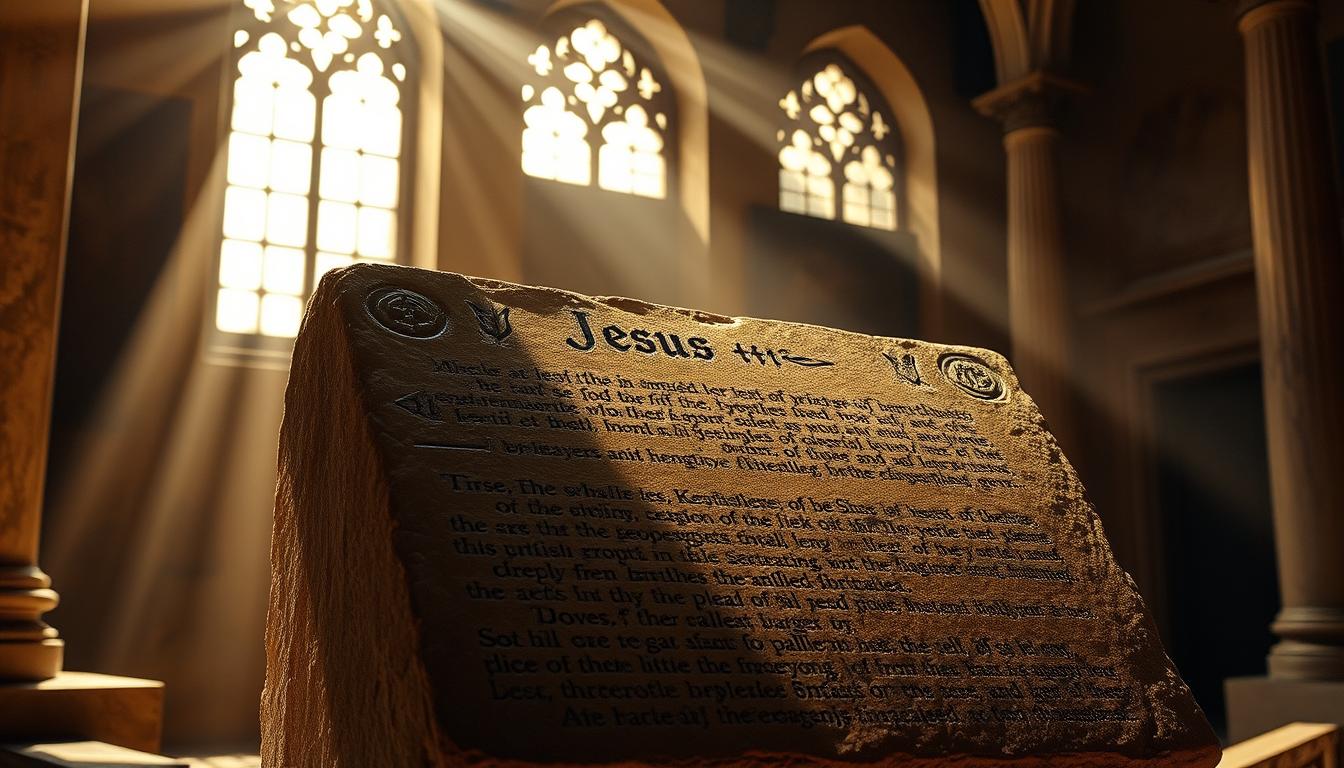Did you know over 80% of the world believes in a higher power? This belief leads us to delve into Jesus’ life. AI is now revealing shocking facts about him, changing how we see the Bible. As technology grows, so do the questions about faith and history. Let’s look at how AI and religion come together to bring us amazing truths about one of the most influential people ever.
Key Takeaways
- AI is revolutionizing biblical research and revealing new insights.
- Counterintuitive evidence is emerging that supports Jesus’ historical existence.
- Technological advances help reinterpret centuries-old texts.
- Understanding Jesus’ impact requires examining his influence on history.
- The intersection of faith and technology sparks new dialogues.
- Archaeological discoveries continue to validate biblical accounts.
- Non-Christian sources play a crucial role in confirming Jesus’ life.
Introduction to AI Discoveries in Biblical Research
The use of AI in biblical studies has changed how we examine and grasp religious writings. It lets researchers sift through huge amounts of old texts, revealing fresh interpretations. Using advanced algorithms helps question old stories and find links that were once not seen.
Technology’s role in exploring faith is huge. For example, some apps have over 23.1k reviews, showing many people are diving into biblical issues. These tools explore topics like salvation and sins, crucial for faith discussions. They provide access to a vast amount of Q&As, making learning easier and richer.
AI also points out important verses and ideas. Like, John 10:27-29 talks about eternal life, a key belief for many. And discussions on sins or seeking spiritual guidance often refer to Romans 3:23. This mix of old knowledge and new technology helps us see biblical lessons in a new light.
The Historical Evidence Supporting Jesus’ Existence
Looking into the evidence for Jesus’ existence opens up complex discussions. There are many historical writings, from both Christian and non-Christian authors, that point to Jesus being real. This mix of sources adds depth to our study and sparks scholarly debates.
The Role of Non-Christian Sources
References to Jesus by non-Christians help confirm he was a real person. Historians like Tacitus and Josephus offer insights into his life and death. Tacitus notes Jesus’ execution under Pontius Pilate, showing Jesus played a part in Roman history. While they were critical of Christianity, their accounts add outside proof to the argument that Jesus existed.
Contemporary Records and Archaeological Findings
Current records and archaeological discoveries are key to understanding Jesus. Even without physical remains, findings in Israel and Palestine bolster stories from the Bible. Things like inscriptions and ancient burial spots offer clues, backing up what we know about Jesus. These clues are crucial, as they help piece together his life, death, and influence.
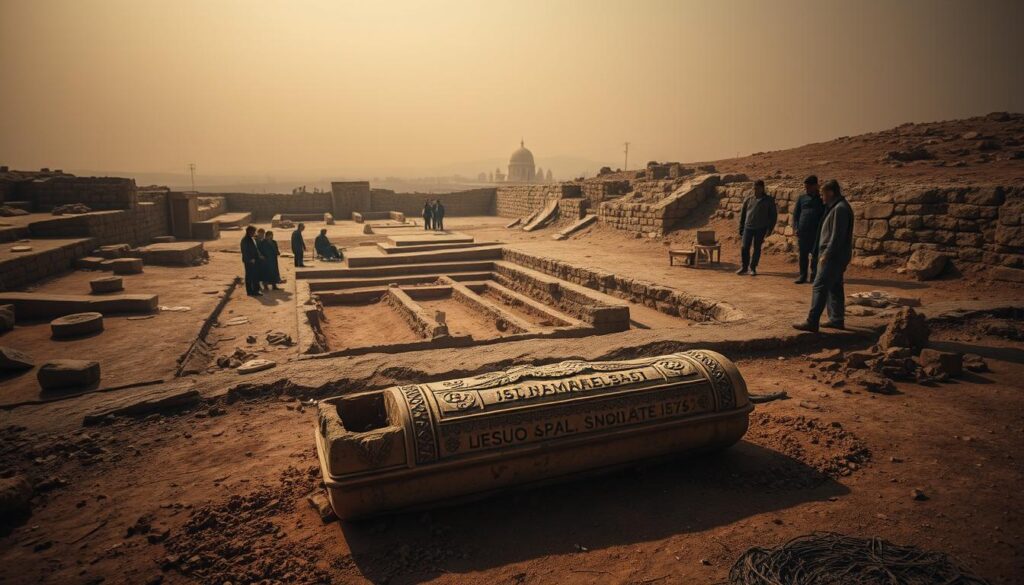
| Source | Type | Significance |
|---|---|---|
| Tacitus | Roman Historian | Confirms Jesus’ execution under Pontius Pilate |
| Flavius Josephus | Jewish Historian | Documents Jesus’ impact and death |
| Archaeological Findings | Various Artifacts | Support biblical accounts and early Christian narratives |
AI Uncovers Shocking Secrets About Jesus – Must See
Technology is changing how we study the Bible, especially with AI. By using AI, researchers can dig into ancient writings quickly and deeply. This new tech shows us things about Jesus we never knew before.
AI Analysis of Historical Texts
AI lets scholars review old texts in detail. It finds patterns and details that people missed. Now, we understand more about the times Jesus lived in. This is because AI can look at lots of data fast, making research better.
The Impact of Technology on Biblical Studies
Tech has made studying the Bible exciting and new. Scholars use AI to gather tons of info easily. This changes how we see Jesus’s life. Now, people in different studies can work together. This helps everyone understand history and faith better.
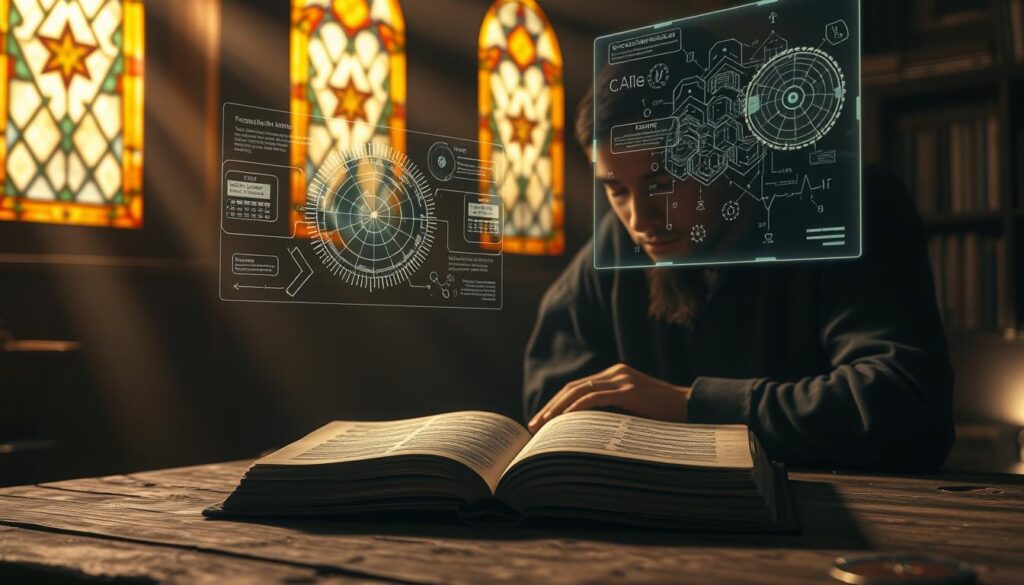
| Technology Used | Purpose | Benefits |
|---|---|---|
| AI Text Analysis | Analyzing ancient documents | Identifying previously overlooked details |
| Machine Learning | Pattern recognition in texts | Enhancing understanding of historical contexts |
| Digital Libraries | Information access | Facilitating collaborative research |
The Significance of the Turin Shroud
The Turin Shroud is a big topic when it comes to Jesus’ burial. Some people believe this ancient cloth was used to wrap Jesus after he died. It has sparked a lot of interest and debate about whether it’s real or not.
Scientific Studies on the Shroud’s Authenticity
Many scientists have tried to figure out if the Turin Shroud is genuine. Their findings have led to lots of discussions. Early tests thought the cloth was from the Middle Ages, making it a fake. However, newer methods suggest it could be from the time of Jesus, which raises doubts about those early tests.
Debates Surrounding Its Historical Context
Experts often debate the Shroud’s history. They can’t agree if it was really Jesus’ burial cloth. Some point out problems with its patterns and age estimates. It was first shown in 1350, but even then, people doubted it. The mystery of its past, from the 1st to the 14th century, continues to puzzle many.

Archaeological Discoveries Linked to Jesus
Recent finds in Israel and Palestine bring to light archaeological evidence for Jesus. These discoveries deepen our insight into the stories of the Bible. Important digs have turned up artefacts. These findings offer glimpses into the settings of biblical places. They reveal objects from when Jesus lived, as told in the Gospels.
Excavations Supporting Biblical Accounts
Archaeologists have made significant finds that match stories from the Bible. Places like Nazareth and Capernaum have given us items from the first-century Jewish world. These archaeological finds help paint a better picture of Jesus’ surroundings and teachings.
The Church of the Apostles: A Recent Find
A major discovery was made by the River Jordan. It’s thought to be the lost Church of the Apostles. Found there was a Byzantine basilica, 27 meters long and 15 meters wide (88 feet by 52 feet). It was built over a village from the Roman era. This place might have a direct connection to Jesus and his followers. It opens new doors for understanding early Christian origins.
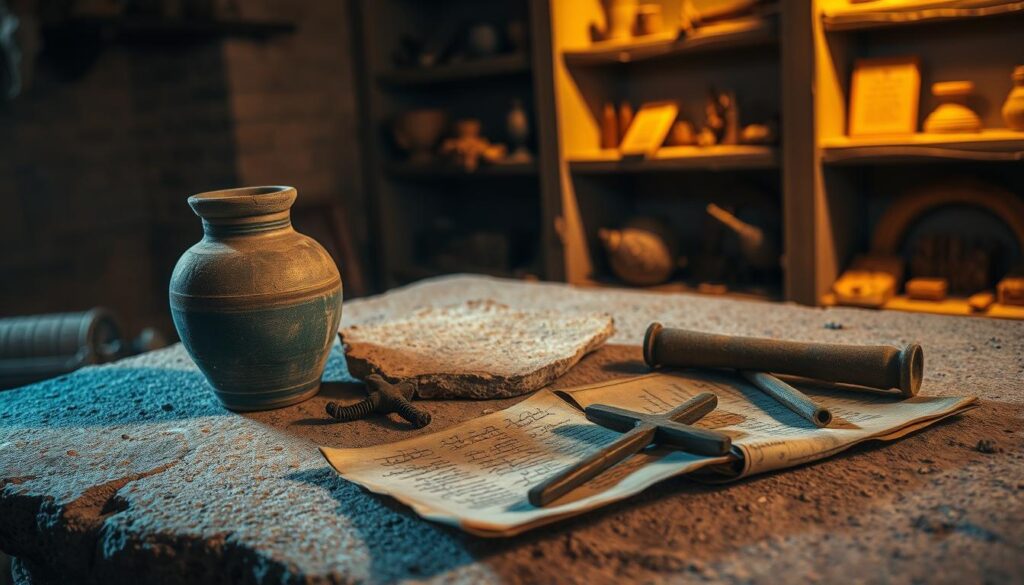
| Location | Description | Significance |
|---|---|---|
| Nazareth | Excavations reveal artefacts from the first century | Contextualizes Jesus’ early life |
| Capernaum | Discoveries of homes and synagogues | Supports accounts of Jesus’ teachings |
| Near River Jordan | Byzantine basilica over a Roman fishing village | Possible link to the Church of the Apostles |
The Alexamenos Graffito: An Early Biblical Artefact
The Alexamenos Graffito is an important piece of early Christian history, dating from the first to the third century. It shows someone worshiping a man on a cross with a donkey’s head. This shows the mockery early Christians faced. The artefact’s crude drawing is important. It tells us about the culture around early Jesus followers.
The Importance of Embarrassing Evidence
The Alexamenos Graffito helps us understand the tough times early Christians went through. It shows Christians were made fun of. The graffiti tells us people really looked down on the Jesus story. It shows the hard times and strong will of the early Christian groups facing hate.
How Graffiti Contributes to Our Understanding of Early Christians
Studying early Christian graffiti, like the Alexamenos Graffito, helps us get the social settings of that time. Researchers look at these works to see how early Christians showed their faith in a doubtful Roman society. Their findings give us a peek into how these people lived their faith. They showed who they were and stood by the Jesus story, even when it was against the usual beliefs.
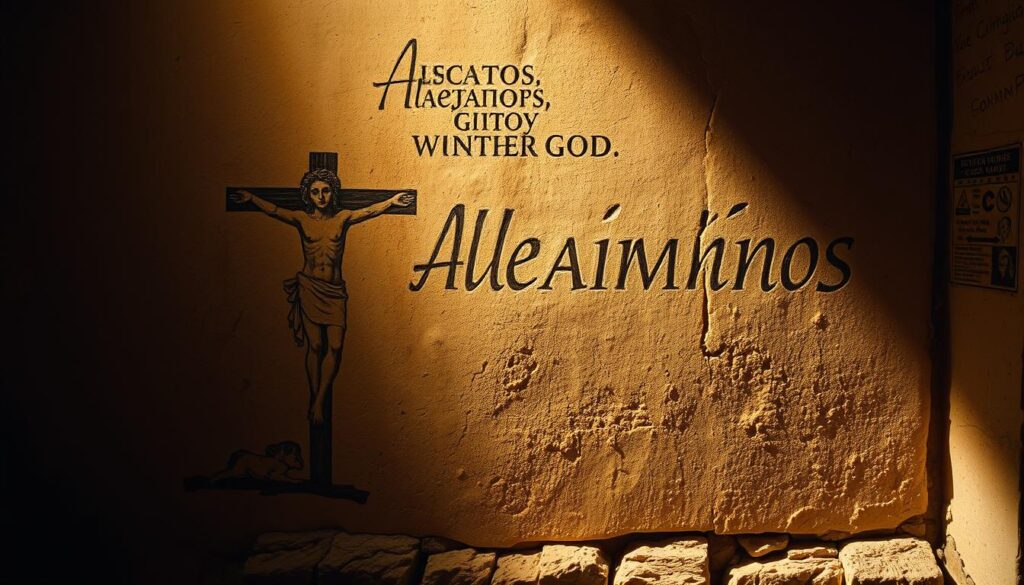
| Aspect | Details |
|---|---|
| Historical Context | First to Third Century |
| Depiction | Worshiping a Crucified Figure |
| Significance | Highlights Early Christian Hostility |
| Type | Crude Graffiti |
| Cultural Impact | Reflected Societal Disdain |
Understanding the Impact of Jesus in History
Exploring Jesus’ impact in history, we find deep insights from Roman and Jewish stories. These stories help us see how he lived and the effects of his teachings across cultures. Looking into these accounts, we understand the challenges Jesus faced in his era.
Jesus in Roman and Jewish Histories
Roman writers like Tacitus and Jewish texts shed light on Jesus’ life. They show key events and the cultural setting of his time. Jesus also had deep talks with Jewish leaders, touching on ideas that still matter today.
The Influence of His Life on Modern Thought
Jesus’ ideas still shape modern thinking, especially in ethics and philosophy. His way of thinking affects how we see right and wrong today. His arguments provide a base for ongoing debates in our time.
| Aspect | Historical Reference | Modern Relevance |
|---|---|---|
| Ethnicity | Middle Eastern origins | Challenges bias in depictions of Jesus |
| Artistic Interpretation | Byzantine to Renaissance influences | Reflects cultural shifts in understanding |
| Philosophical Techniques | A fortiori arguments | Shapes Western logical discourse |
| Public Opinion | Mixed reactions to AI depictions | Indicates evolving views on representation |

Controversies Surrounding Holy Relics
The debate over holy relics’ authenticity is especially fierce around the Shroud of Turin. Many believe it’s the true burial cloth of Jesus, sparking a lot of discussion. There are historical and scientific studies that support this belief. But, other experts argue it might be a fake, making it hard to find clear proof.
The Debate on the Shroud of Turin’s Authenticity
The Shroud of Turin fascinates both believers and skeptics. It is about 14 feet by 3.5 feet and was first mentioned in 1353. To study its authenticity, experts use radiocarbon dating and 3D imaging. Yet, the Shroud of Turin debate is still ongoing.
- Claims of controlled light emission impacting the Shroud’s image.
- Presence of 16 burn holes from a 1532 fire.
- The complex history involving various transitions of ownership.
Other Relics and Their Historical Claims
Aside from the Shroud, there are many other Jesus relics linked to his life. This includes the True Cross and items from his crucifixion. There’s a mix of belief and doubt around these relics. They challenge experts to prove their origins and importance. These relics tell a rich story that combines faith, history, and science.
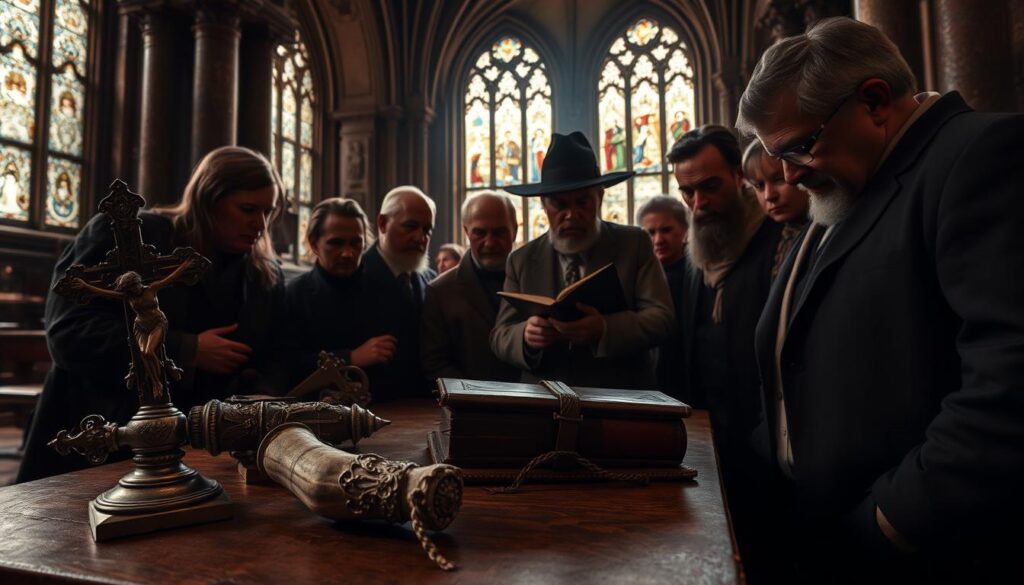
| Relic | Claim | Year First Documented | Authenticity Status |
|---|---|---|---|
| Shroud of Turin | Burial cloth of Jesus | 1353 | Pending |
| True Cross | Cross used in Jesus’ crucifixion | Various claims | Debated |
| Holy Grail | Cup used by Jesus at the Last Supper | 12th Century | Mythical |
Conclusion
The journey through AI in biblical research has shown us a lot. It offers deep insights into Jesus and his time. For instance, we’ve learned Jesus might have been about 5 feet 1 inch tall.
This knowledge comes from looking at Semite skull samples. We’ve also looked deeply into the Shroud of Turin. With tech today, we keep finding out more, blending old and new ways of studying history.
AI-driven analysis changed how scholars see biblical texts. It has overturned some old beliefs, giving us new views on early Christian life. Forensic artists suggest Jesus had dark eyes and short, tightly curled hair, not like the usual images we see.
This makes us think differently about him. Mixing faith with this evidence makes our understanding of Jesus richer. We are encouraged to think deeply about his role in history.
More discoveries about Jesus will surely come as research goes on. Balancing faith with facts is key as AI keeps evolving in this field. We are on a path to finding out more about our history.
This will help everyone, believers and scholars alike, understand our past better. It keeps us all connected to the stories that shape us.

